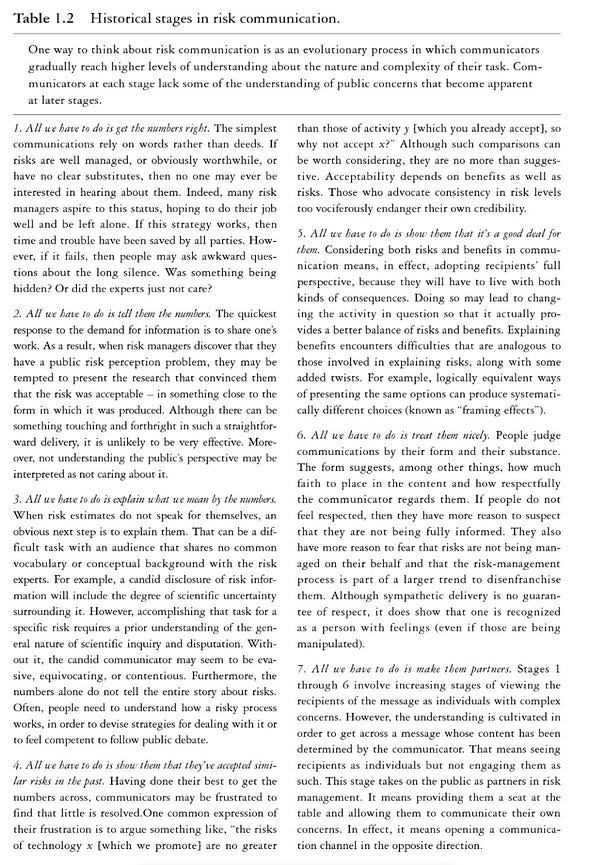Risk communication
“…when [people] see experts failing, laypeople can effectively assert their desire to affect both personal and political decisions. These battles for control may not be quick or tidy processes. […]
Once specialists lose the trust needed to serve as credible sources, the public’s learning process becomes much more complicated. Laypeople no longer know where to go for information. Their interactions with risk specialists may be colored by emotional reactions by all parties.”
Sound familiar? Let’s take a minute to talk about communicating risk. The above quote isn’t a recent retrospective on the coronavirus pandemic. Instead, it’s from Risk Communication: A Mental Models Approach, a 2002 guide to the discipline.
With various regions in the US potentially going back under some sort of lockdown or “stay at home” order, there’s been a resurgence in people talking about openly flouting restrictions of various kinds. How did we get to this point?
To address the elephant in the room: we can’t ignore the many systemic failures of governance here in the US. For instance, the false choice between public health and the economy (partially driven by the lack of any substantial stimulus or financial backstop by the federal government) is a commonly stated reason to ignore restrictions. Cynicism and a lack of trust also contribute—”why should I comply,” you might ask, if our leaders are ignoring their own messages?

What if we zoom in a bit further from these macro issues, though, and look at some other contributing factors? I think our risk communication shortcomings are certainly up there. Broader public health issues like supply chain failures and hospital capacity rightfully remain in the headlines.
But—and I believe equally importantly— discussion of risk communication has remained under the radar, generally limited to academic comment.
What missteps did we make along the way? Let’s revisit the risk communication guide I mentioned at the beginning. A table from the book, reproduced from an earlier 1995 article by Fischhoff, makes for a good place to start. It traces the evolution of a communication project over time. The examples in the table are framed around the acceptance of a risk, but the same principles work the other way around for our current pandemic moment. Let’s take a look at few of the “stages” he highlights in this process.
Stage 1
“All we have to do is get the numbers right.”
It’s February 2020. Those of us in the US are becoming more aware of the effects of the pandemic in China and parts of Europe, but the federal government in the US is downplaying the threat.
Similarly, the U.S. Surgeon General initially downplays the importance of masks at the end of February. Perhaps it was a misconception, or perhaps an effort to save supplies of critical PPE with a heavily burdened supply chain at the time.
As the table states: “If risks are well managed […] then no one may ever be interested in hearing about them.” With the benefit of hindsight, we know that this was wishful thinking and that critical time was lost.
The table goes on: “…if [the strategy] fails, then people may ask awkward questions about the long silence. Was something being hidden? Or did the experts just not care?” That’s, unfortunately, a bit more like it.
Stages 2 and 3
“All we have to do is tell them the numbers” and “All we have to do is explain what we mean by the numbers.”

It’s March, April, and May. The pandemic has hit the US. It’s in full swing as the first wave sweeps across various parts of the US—first Washington and New York, then a quick progression elsewhere.
Political leaders emphasize the importance of doing your part for your city or state. We’re inundated by numbers and curves. Case counts, positivity rates, death rates, and hospital capacity statistics all come up as justifications for how we need to collectively respond. They’re explained by governors, mayors, and the rare federal spokesperson (basically, Dr. Fauci). Often, these numbers aren’t even risk assessments, but are instead raw statistics. Yet:
“Numbers alone do not tell the entire story about risks. Often, people need to understand how a risky process works, in order to devise strategies for dealing with it or to feel competent to follow public debate.”
Unfortunately, many communication methods are stuck here years later.
</I’m no expert in the field and I don’t have any big ideas for those in our hospitals, governments, and newsrooms. However, I think we’d do well to consider our prior experience communicating about the pandemic—and, yes, our prior experience defining the entire field of risk communication.